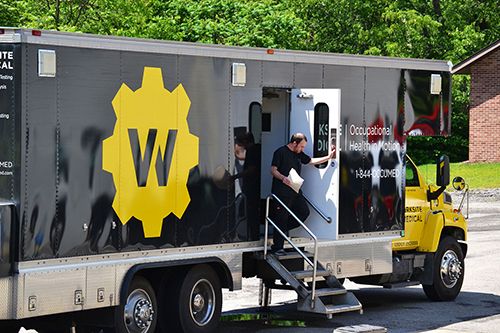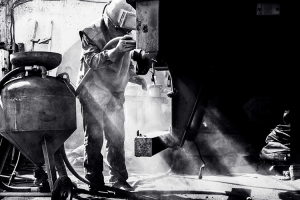More foundries means better chance of OSHA inspection
According to new federal OSHA requirements, metalcasting facilities throughout the U.S. must cut airborne silica exposure in half by June 23. No states will be affected by the new rule more than Ohio and Pennsylvania
The neighboring states rank No. 1 and No. 2, respectively, when it comes to the amount of metal foundries per state – Ohio has 157, while Pennsylvania has 131. The last foundry hit with a large OSHA fine for silica exposure, which occurred in 2015, was based in Ohio.
Also, a quick Google search for “foundries OSHA fines” will reveal that the vast majority – six-of-ten, in my case – of foundries fined are from one of the two states.
Needless to say, the states with the most facilities likely carry the biggest targets for OSHA inspectors.
How foundry workers are affected
According to the American Foundry Society (AFS), “the U.S. foundry industry uses millions of tons of silica sand per year in the production of critical metal castings.”
Foundry workers experience respirable crystalline silica exposure when casting sand, fettlings and kiln linings produce dust. Overexposure may lead to deadly diseases, such as silicosis, lung cancer, COPD, and/or kidney disease.
According to OSHA, abrasive blasting — sandblasting in order to clean and smooth irregularities from foundry castings — causes the most severe exposure.
Various industry groups challenged the OSHA silica rule before the U.S. Court of Appeals for the District of Columbia Circuit, however the court rejected “all of industry’s challenges.”
In an interview with Bloomberg earlier this month, Mike Wright, director of health and safety for the United Steelworkers, explained that his suspicion is that employers have been slow to comply.
“I suppose some were hoping that the courts would bail them out, for which we have no sympathy,” Wright said.
Last year, two delays occurred during the silica rule enforcement for construction. The first pushed implementation from June to September, while the second offered “good faith” assistance during the first 30 days to employers that were making good efforts to meet the new requirements.
It’s not likely that OSHA will be so forgiving this time around.
Necessary steps for compliance
(Free Download: Silica Rule Requirements)
Written Exposure Control Plan
Your company must prepare and implement a written exposure control plan that identifies tasks which could create exposures and the methods your company will use to protect workers.
Housekeeping
Housekeeping practices such as dry sweeping, dry brushing, and the use of compressed air (unless used in conjunction with a ventilation system) which expose workers to silica where feasible alternatives are available is not allowed.
Training
Worker training in silica exposure is required. Workers must be able to demonstrate: knowledge of hazards, specific tasks which could cause exposures, the employer’s methods of controlling exposures, information from the standard and the purpose and description of the medical surveillance program. To help document demonstration of knowledge, you may want to give a quiz.
Record-keeping
Your company must keep detailed records of silica exposure and medical exams on file. For general industry/maritime, it’s all detailed exposure sampling records. How your company chooses to comply with the standard will determine which records you keep.
How we can help
Initially, employers must offer medical surveillance testing to employees exposed above the PEL for more than 30 days per year. However, beginning on June 23, 2020, the rule will become even more strict.
At that point, testing will need to be offered when exposure is at or above the action level — 25 μg/m3, or a mere 420 micrograms — instead of the PEL.
Aside from medical surveillance testing, which includes standard medical and physical examinations, any employees that are exposed above the action level for 30 days or more per year must be offered chest x-rays & lung function tests every three years.
Though, no matter what, the initial required testing must include the following: completion of a Medical History Questionnaire, a Physical Examination, a Chest X-Ray with B-Reader, a Pulmonary Function Test, and a Tuberculosis test. Furthermore, additional testing is necessary outside of the silica standard when employees are wearing respirators, such as completing an initial respirator medical questionnaire and respirator fit testing.
At Worksite Medical®, we help companies of all sizes become OSHA-compliant. We offer mobile medical testing, which means we will bring the clinic directly to your job site, and efficiently test your workers at a pace that limits downtime to maximize your workplace productivity.
We also have standalone clinics in Ellwood City, Pa. (just minutes from the Penn-Ohio border) and Belcamp, Md., if you’d prefer to send your workers for testing at their convenience.
(Related: Learn More About Mobile OSHA Silica Testing)
Are You in Compliance?

Create a Less Disruptive, More Productive Occupational Health Plan with Worksite Medical!
Are you looking for a way to keep your team safe, while also limiting risk and increasing production? Simplify your medical plan today. We help team leaders like you develop less disruptive, more convenient occupational health plans that comply with complex industry standards, thus creating a healthier, more productive workforce. Take control of your medical testing program.




